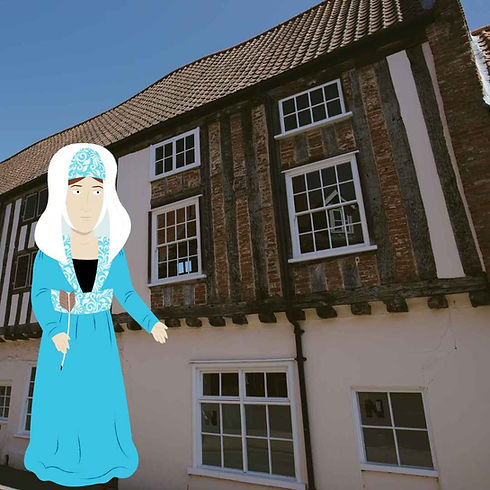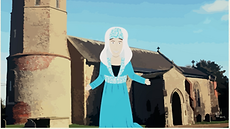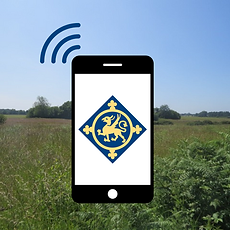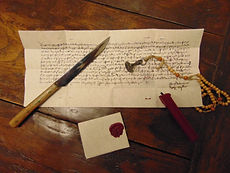Margery Brews Paston
Author of the first Valentine letter and shrewd marriage negotiator, 1446 - 1495.
Perhaps the best known Paston documents is penned by Margery, the world's earliest Valentine letter, but what about the whole of her life? Her voice and story have been hiding in plain sight, within the letters. By creating this page we're writing Paston women back into history.


Margery's 1477 letter begins 'My right well-beloved Valentine’ and she signs her letter as 'Be your Voluntyne / Mergery Brews'.
Image of ther signature:
c. BL, Add MS 43490, f. 24r.
Find out more about Margery




Biography by Michele Schindler
Author, historian, based in Germany.
Like most of the women in her family, Margery Paston is mainly remembered in connection with a man.
In her case, however, this is because of her own words: her loving Valentine`s letters to her intended, the man she was to eventually marry: John Paston III. This letter has been called the first Valentine`s letter, as it is the first such letter which has survived into the 21st century, but it would be a mistake to reduce Margery simply to this. She was, by her own words, a woman in love, but she was much more than that: she was a determined young lady who knew what she wanted, and knew how to get it.
Margery was the daughter of Sir Thomas Brews and his wife Elizabeth Brews, a family who, like the Pastons, were on the make. Her birth year is disputed, with some claims putting it as early as 1446, making her nearly contemporary with her future husband, and others thinking she was significantly younger, and probably born in the mid 1450s. This is a question that cannot be solved, but what is known is that by 1477, she had not yet been married.
There might have been negotiations for her marriage that failed, for it is known that her father, Sir Thomas Brews, wanted to use her marriage for financial advancement. Naturally, this was completely normal at the time, but by 1477, Margery had come to her own decision who she wanted to marry: she had fallen in love with John Paston III.
John was, it seems, a bit of a lady`s man, and Margery was not the only woman who harboured hopes of marrying him. Several other women are mentioned in connection with him in the Paston letters, but despite this, it seems that he returned Margery`s feelings. Despite having other options, he wished to marry her too.
Despite this mutual wish, things did not run smoothly. Though their family background was quite similar, their families were less than delighted when Margery and John announced this to them and expressed their wish to get married. Sir Thomas Brews wanted his daughter to marry someone richer, while John Paston III`s older brother - confusingly also named John Paston - was less than delighted at his brother choosing a wife whose father “is so hard”. - 9 March 1477. James Gairdner, The Paston Letters, AD 1422–1509. Volume V. New Complete Library Edition (London: Chatto & Windus, Exeter: James G. Commin, 1904) p.274. John himself seems to have wanted to be promised a bigger dowry before agreeing to marry her.
Luckily for the two love birds, not all their relatives were against the match. Margery`s mother Elizabeth, especially, supported her daughter`s wishes and decided to intercede with her husband, to try and convince him of the match. Several letters of her to her prospective son-in-law survive, among them one in which she details the monetary arrangements her husband expected for the marriage, which was clearly more of a drain on John Paston`s purse than he was able to pay. Perhaps realising this, Elizabeth`s letter includes a lovely description of Margery as “a greater treasure” than any money he would lose, “a witty gentlewoman”, who was “both good and virtuous, for if I should take money for her, I would not give her for a thousand pounds”. p.265.
Though naturally, her mother was hardly an impartial judge of character, it is easy to find confirmation for her words, for Margery`s wit, in the letter she wrote to the man she wished to marry only days after her mother sent this letter, the Valentine`s letter that she is mainly remembered for today. In it, she addresses John as “my right well beloved Valentine”, and assuring him that she was not “in good health of body, nor of heart, until I hear from you, for there knows no creature what pain I endure, and for it to be done, I dare it not discover”. (This is a rhyme in the original: “for there wottys no creature what peyn that I endure, and for to be deede, I dare it not discoure”). (14 February 1477, p.267)
Touching on the problematic discussions of the details of their marriage between her father and his brother, Margery went on to say that her mother had not yet managed to get her father to agree to anything but what he had first demanded, but went on to say that “if you love me, as I trust verily that you do, you will not leave me therefore; for that if you had not half the livelihood that you have, for to do the greatest labour that any woman on life might, I would not forsake you.” (14 February 1477, p.267)
Clearly, even when in love, and worried about whether the future she had chosen for herself was going to happen, Margery was capable of remaining cooly logical, realising the risk of John Paston reacting badly to her father`s wishes, confident enough in his life to assure him she was worth any financial loss he would suffer through marrying her, and remaining witty enough to attempt a little rhyme in a clearly heartfelt letter.
In the end, Margery`s fears of John leaving her or her father not agreeing to the marriage did not come true, due to the intervention of another woman: John`s mother Margaret. Clearly thinking that Margery was a suitable bride for her son, or else realising that he wanted her and supporting this, in March 1477 she suggested “a jointure to be made in Swynsthorpe in hand, and a jointure of no more but ten mark ought of Sparham”. (9 March 1477, pp.275/6) This was enough for both Sir Thomas and John`s brother to eventually agree to the match, and the marriage went ahead, at some point in 1477.
Having fought for their marriage, it seems that John and Margery enjoyed a happy ending. Their marriage appears to have been a good one, as letters written by Margery attest. Again, several of these letters show her sense of humour, such as when she wrote to him on 18 December 1477, just some months after their marriage, mentioning a “ring with the image of St Margaret” that she had sent him “for a remembrance, till you come home”; to this, she then added “you have you have left me such a remembrance, that maketh me think upon you both day and night when I would sleep”. (18 December 1477, p.308)
This remembrance left by her husband was, in fact, a pregnancy: by the time she was writing this letter, Margery must have been aware that she was expecting a child - their first son, as it would turn out, whom they would go on to name Christopher.
Other letters of hers during the course of their marriage also show that their affection had not waned, and intriguingly, in some of them Margery plainly expresses her sexual desire for her husband. One such letter is from 1 November 1481 (or possibly 1484, this is disputed), written to John while he was in London, a letter which Margery concluded by saying “Sir, I pray you, if you tarry long at London that it will please you to send for me, for I think it a long time since I lay in your arms” (1 November 1481, https://quod.lib.umich.edu/c/cme/Paston/1:14.3?rgn=div2;view=fulltext) - a lovely reminder of human emotions and desires which have not changed over the centuries, but which are often neglected when discussing medieval marriages. Though often taken simply as a sign of her love for her husband, Margery`s letter therefore also show her as a woman confident to express her own sexual desires and playfully demand her husband fulfil them - a sexual confidence often considered to have been alien to women in medieval marriages.
Sadly little is known about Margery and John`s life together, other than that clearly, they shared a happiness in their union. Margery gave John at least three children: Christopher, who was born in 1478, but must have died in childhood. William, born around a year later, who survived both his parents, and Elizabeth. It is known since 2019, when her tomb was discovered, that John also had a daughter called Anne, but it is not known if Margery was her mother, or if she was the daughter of John`s second wife, whom he married after her death.
Margery died in 1495, probably at the age of around forty years old. What exactly she died of is sadly unknown, as is her exact death day and her burial place. She was survived by her husband and son. Though comparatively little is known about her life, her letters to John Paston give us a glimpse of a witty, confident and smart woman, someone with whom we can still relate today, over 500 years later.
How do you imagine Margery?
Browse through some examples below of how people have brought Margery Paston to life. Inspired to imagine the Paston women in your own way? Share your performance, poem, cake, blog, drawing or any other kind of creative work.
Post your creation on social media with the tag #pastonfootprints or email us Pastonfootprints@gmail.com. See our policy page for terms of publication on this gallery.






